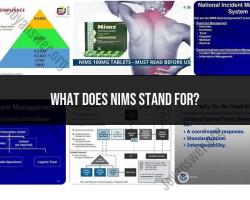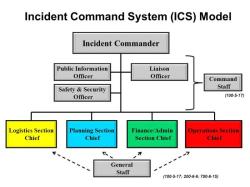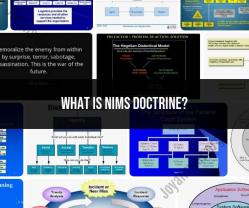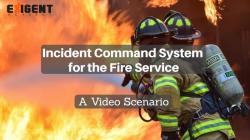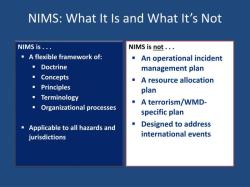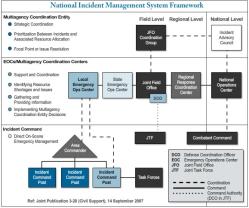What is the difference between Nims and ICS?
NIMS (National Incident Management System) and ICS (Incident Command System) are both frameworks designed to enhance the effectiveness of emergency response and management. While they share common goals and principles, they serve different purposes within the broader context of emergency management. Here are the key differences between NIMS and ICS:
NIMS (National Incident Management System):
Scope:
- Comprehensive Framework: NIMS is a comprehensive framework that encompasses the entire spectrum of incident management, including preparedness, response, recovery, and mitigation.
- National Level: NIMS is designed to be applied at a national level, providing a standardized approach to incident management across the United States.
Applicability:
- All Levels of Government: NIMS is applicable to all levels of government, as well as to private sector organizations and non-governmental entities involved in emergency management.
- All Hazards: NIMS is designed to be flexible and applicable to any type of incident, regardless of size or complexity. It is an all-hazards approach.
Components:
- Five Components: NIMS consists of five key components: Command and Management, Preparedness, Resource Management, Communications and Information Management, and Ongoing Management and Maintenance.
Implementation:
- Required for Federal Funding: Compliance with NIMS is required for federal funding for emergency management and incident response activities. State and local agencies must adopt NIMS to be eligible for certain federal grants.
ICS (Incident Command System):
Scope:
- Focused on Response: ICS is primarily focused on the management of incident response. It provides a standardized organizational structure for managing and coordinating on-scene response efforts.
Applicability:
- Primarily Tactical: ICS is designed for on-scene, tactical operations during the initial response phase of an incident. It is particularly effective for managing incidents that require a coordinated multi-agency response.
Components:
- Basic ICS Structure: ICS consists of a basic structure, including Incident Command, Operations, Planning, Logistics, and Finance/Administration sections. The structure is scalable and can expand or contract based on the size and complexity of the incident.
Implementation:
- Mandated by Federal Law: ICS is mandated by federal law for use in responding to incidents involving federal agencies. It is widely adopted and used by emergency responders at all levels of government.
Relationship:
Interconnected: NIMS and ICS are interconnected, and ICS is a key component of NIMS. ICS serves as the incident management component within the broader NIMS framework.
Unified Approach: Together, NIMS and ICS provide a unified approach to incident management, ensuring a coordinated and effective response across different agencies and jurisdictions.
In summary, NIMS is a comprehensive national framework that encompasses the entire incident management process, while ICS is a specific organizational structure and management system used primarily during the response phase of an incident. ICS is a key component of NIMS and is widely used in emergency response and management across the United States.
What are the fundamental differences between Nims and ICS?
The Fundamental Differences Between NIMS and ICS
NIMS and ICS are two important frameworks for emergency management. While they are often used interchangeably, they have distinct roles and responsibilities.
Scope
NIMS provides a standardized nationwide framework for managing all types of incidents, from natural disasters to terrorist attacks. It establishes common terminology, processes, and structures to facilitate effective collaboration among different response agencies and jurisdictions. ICS serves as the on-scene organizational structure for managing specific incidents. It defines roles, responsibilities, and reporting relationships within a unified command structure to ensure coordinated and efficient response efforts.
Focus
NIMS emphasizes preparedness, planning, and resource management at all levels of government and the private sector. It aims to create a consistent approach to incident response across the nation. ICS focuses on tactical incident management at the scene. It provides a flexible framework that can be adapted to the specific needs of each incident, regardless of size or complexity.
Structure
NIMS does not have a specific organizational structure. It provides principles and guidance that can be applied to various existing structures. ICS defines a hierarchical organizational structure with specific roles and responsibilities for incident management personnel. This structure can be scaled up or down depending on the incident's size and complexity.
Relationship
NIMS provides the foundation for ICS implementation. The principles and standards outlined in NIMS guide the development and deployment of ICS at the incident scene. ICS represents the operational arm of NIMS. It puts the NIMS principles into practice by establishing a unified command structure for managing specific incidents.
In essence, NIMS sets the stage for effective incident response, while ICS is the tool used to orchestrate the response on the ground. Both are essential components of a comprehensive emergency management system.
Here are some additional details about the differences between NIMS and ICS:
- NIMS is a top-down approach, while ICS is a bottom-up approach. NIMS provides the overall framework and guidance, while ICS is implemented at the scene by the incident management team.
- NIMS is more general, while ICS is more specific. NIMS covers all types of incidents, while ICS is focused on the tactical management of specific incidents.
- NIMS is more comprehensive, while ICS is more focused. NIMS includes preparedness, planning, and resource management, while ICS is focused on the immediate response to an incident.
NIMS and ICS are both important tools for emergency management. By understanding the differences between the two frameworks, you can better understand how they work together to help ensure a coordinated and effective response to any incident.


